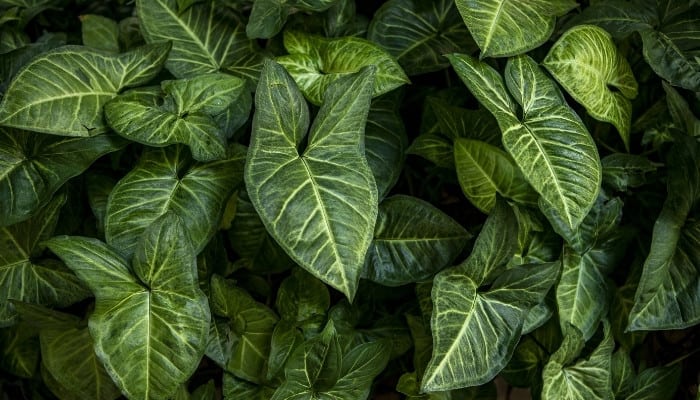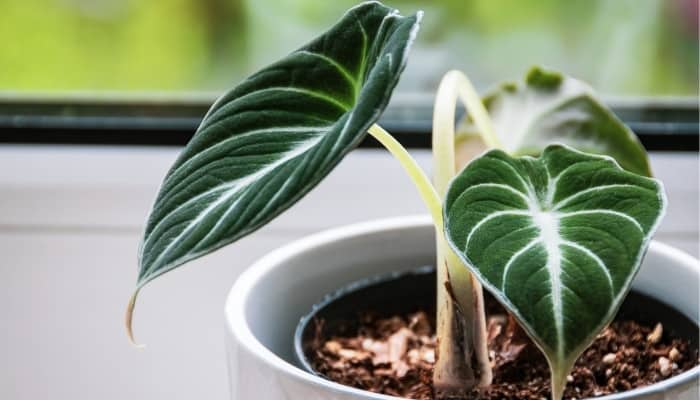Alocasia, also known as elephant ears, are tropical plants typically used for indoor decoration, which can make a bold statement. As time passes, you may notice indications that your alocasia is becoming rootbound.
This may cause you to wonder whether it is best to repot this type of plant.
Do alocasia like to be rootbound? Alocasia plants prefer to be slightly rootbound as this condition not only mimics their natural environment but also encourages foliage growth and prevents the roots from staying wet and developing root rot. Once you see signs of extreme overcrowding, the plant may be moved to a slightly larger pot.
In this article, you’ll learn why alocasia prefers to be slightly rootbound, as well as other plants that prefer to get a little crowded.
Keep reading to learn when it’s time to move your alocasia to a roomier space.
Why Alocasia Prefers Being Slightly Rootbound
While some plants, like those in the Alocasia genus, prefer to be somewhat rootbound, others require plenty of room for their roots to stretch out.
What makes alocasia so much happier in a rootbound environment?
Prevents the Root Environment From Being Overly Saturated
Densely packed soil or other potting media can quickly become soggy from excessive watering, and even tropical plants like alocasia don’t like to be saturated.
While a loose potting medium will reduce the risk of sogginess, being rootbound will help even more.
The alocasia’s roots keep the soil loose and aerated when slightly rootbound, protecting against root rot.
Plant Puts More Energy Into Foliage Growth
Alocasia usually put as much growth into their roots as they do into their foliage and flowers.
However, a rootbound alocasia doesn’t have a lot of room for more roots, so it pushes all of that growth energy into the foliage above the dirt.
Allowing your alocasia to get slightly rootbound will mean a more prominent, showier plant.
Mimics Natural Confined Growing Environments
In the wild, alocasia grows on the forest floor of the tropical rainforests and marshes of Southeast Asia and Australia.
They are densely packed in with all the other plants and their roots. This means that wild alocasia are slightly rootbound all the time.
By allowing your alocasia to become slightly rootbound before you repot it, you’re mimicking the natural environment in which it evolved.
As with many plants, providing an environment close to what they would have in nature is key to keeping your alocasia happy and healthy.
Do All Alocasia Plants Like To Be Rootbound?
All varieties of alocasia plants prefer to be slightly rootbound rather than having a too-large container. These tropical plants all like to be a little bit crowded as they would be in the wild.
Whatever cultivar of alocasia you have, it will be much happier if you let it outgrow its pot completely before trying to repot it in a larger pot.
When To Repot Alocasia

Your alocasia will be happiest if you wait until it shows signs of being too rootbound before you try to repot it.
Fortunately, they tend to let you know when they’re ready to spread out a little more. There are several signs to look for that will help you decide when to repot your alocasia.
- Rogue Roots – If you start to notice that your alocasia has roots escaping out of the top of the soil or through the drainage hole at the bottom of the pot, it’s time to repot.
- Difficulty Watering – When you water your alocasia, if the water runs straight through the bottom of the pot, it may be time for a bigger pot. Wilting between watering is also a sign to repot.
- Look Inside – Place one hand gently around the base of your alocasia, and hold the pot with your other hand. Ease the root ball out of the pot and examine the roots. If it looks like there are more roots than soil, it’s time to repot.
What Happens When a Plant Gets Rootbound?
Most plants naturally become rootbound after some time in the same pot. Different types of plants respond differently to being rootbound.
For plants that prefer being rootbound, such as alocasia, peace lilies, snake plants, and Boston ferns, you’ll notice that they start to flourish a bit more when they get crowded.
Alocasia and peace lilies produce flowers but are unlikely to do so until they are slightly rootbound.
On the other hand, some plants are susceptible to crowding and want to be repotted frequently.
These plants will start to show distress right away if they get too big for their pots. They may start wilting or even fall over because they’re too top heavy.
Related Questions:
Here are some other common questions about rootbound plants.
Which Plants Don’t Like To Be Rootbound?
Monstera deliciosa is one plant that prefers plenty of room to stretch its roots. When it becomes even slightly rootbound, it can become top heavy and fall over.
Even worse, its enormous leaves will start to wilt if it starts to get too big for its pot.
Another plant that hates to be rootbound is the weeping fig. These plants are known to be so temperamental that they will drop leaves at the slightest sign of crowding.
Repot plants like the weeping fig every year or two to give them plenty of room to spread out.
How Long Can a Rootbound Plant Survive?
How long a rootbound can survive depends on the type of plant and how rootbound it is. A plant that prefers to be rootbound, like the alocasia, can thrive until it cracks its pot.
On the other hand, a more temperamental plant like Monstera deliciosa will start to show signs of distress almost immediately and will die not long after.
Conclusion
Indoor alocasia plants are happiest and healthiest when you can replicate their natural growing environment as much as possible.
This means they like bright, indirect light and loose soil, like their native rainforest floor.
It also means they prefer to be slightly rootbound, so wait until it shows signs of overcrowding before moving it to a larger pot.

